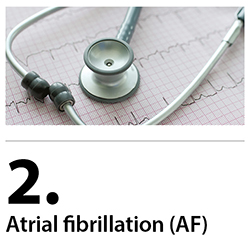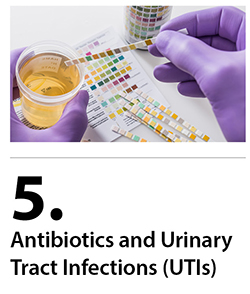Medically, you might be interested in…
A regular series on the latest clinical studies from around the world – and what they mean ‘in practice’, compiled and written by Clare GP Dr Ray O’Connor
**********
Dr Ray O’Connor
While the Covid-19 pandemic is less in the news of late, it is still impacting greatly on healthcare. The theme emerging from recent research is that while vaccines may not prevent infection, those who are vaccinated are less likely to get very ill or die. There are also many new variants of the virus with different degrees of infectivity and severity. Current vaccines also provide a variable level of protection against these variants. The duration of this protection is also unclear.
One retrospective observational American study1 looked at whether the increase in post-vaccination infections during the summer of 2021 was caused by declining immunity over time, the emergence of the Delta variant, or both. The researchers extracted data  regarding Covid-19–related vaccination and outcomes during a nine-month period for approximately 10.6 million North Carolina residents. They aimed to estimate the effectiveness of the Pfizer, Moderna, and Johnson & Johnson–Janssen vaccines. They concluded that all three Covid-19 vaccines had durable effectiveness in reducing the risks of hospitalization and death. Waning protection against infection over time was due to both declining immunity and the emergence of the Delta variant.
regarding Covid-19–related vaccination and outcomes during a nine-month period for approximately 10.6 million North Carolina residents. They aimed to estimate the effectiveness of the Pfizer, Moderna, and Johnson & Johnson–Janssen vaccines. They concluded that all three Covid-19 vaccines had durable effectiveness in reducing the risks of hospitalization and death. Waning protection against infection over time was due to both declining immunity and the emergence of the Delta variant.
A prospective observational study from America2 also looked at this. The authors concluded that mRNA vaccines were found to be highly effective in preventing Covid-19 associated hospital admissions related to the Alpha, Delta, and Omicron variants, but three vaccine doses were required to achieve protection against Omicron similar to the protection that two doses provided against the Delta and Alpha variants. Vaccinated patients admitted to hospital with Covid-19 had significantly lower disease severity than unvaccinated patients for all the variants.
Another observational study from Hong Kong showed similar results. During January–March 2022, reported Covid-19–associated deaths rose rapidly. Among these deaths, 96 per cent occurred in persons aged ≥60 years. Within this age group, the risk for death was 20 times lower among those who were fully vaccinated compared with those who were unvaccinated.3
What about using different vaccines in the course of vaccination? A paper from the American Centers for Disease Control4 concluded that all eligible persons should receive recommended Covid-19 booster doses to prevent moderate to severe Covid-19. Adult Janssen primary vaccine recipients should preferentially receive a heterologous mRNA vaccine (e.g. Pfizer or Moderna) booster dose at or more than two months later.
What about the fourth dose of Covid vaccine? How effective is it? On 2 January 2022, Israel began administering a fourth dose of Pfizer vaccine to persons 60 years of age or older. The researchers estimated the rate of confirmed infection and severe Covid-19 after receipt of a fourth dose, as compared with that among persons who had received only three doses.5
They concluded that rates of infection were lower after a fourth dose of the vaccine than after only three doses. Protection against confirmed infection appeared short-lived, whereas protection against severe illness did not wane during the study period.
For those of us who have had both the infection and a subsequent vaccine course, what kind of protection does this provide against subsequent Covid infection? A team in the United Kingdom studied the duration and effectiveness of immunity in a prospective cohort of asymptomatic healthcare workers.6
Vaccine effectiveness (at or less than ten months after the first dose of vaccine) and infection-acquired immunity were assessed. They found that two doses of Pfizer vaccine were associated with high short-term protection against SARS-CoV-2 infection; this protection waned considerably after six months. However, infection-acquired immunity, boosted with vaccination, remained high more than one year after infection.
More recently, we have begun vaccinating children. Another report from MMWR7 looked at how effective this was during July 2021–February 2022. Approximately one half of Omicron infections in unvaccinated children and adolescents were asymptomatic. Two doses of Pfizer vaccine reduced the risk of Omicron infection by 31 per cent among children aged 5–11 years and by 59 per cent among persons aged 12–15 years.
Finally, how safe are all these vaccines? A combined team from Barcelona and Oxford studied the risk of developing immune mediated neurological events with Covid-19 vaccines – using primary care records from the UK and Spain.8 The records of 8,330,497 people who received at least one dose of Covid-19 vaccines Astra-Zeneca, Pfizer, Moderna, or Johnson & Johnson–Janssen between the rollout of the vaccination campaigns and end of data availability in June 2021 were studied.
The study concluded that no increased risk was observed between Covid-19 vaccines and the immune mediated neurological events of Bell’s palsy, encephalomyelitis, Guillain-Barré syndrome, and transverse myelitis. However, an increased risk of was observed for people with SARS-CoV-2 infection.
References:
- Lin DY et al. ‘Effectiveness of Covid-19 Vaccines over a 9-Month Period in North Carolina’. N Engl J Med 2022;386:933-41.
- Lauring AS et al. ‘Clinical severity of, and effectiveness of, mRNA vaccines against, Covid-19 from Omicron, Delta, and Alpha SARS-CoV-2 variants in the United States: prospective observational study‘. BMJ 2022;376:e069761.
- Smith DJ et al. ‘COVID-19 Mortality and Vaccine Coverage — Hong Kong Special Administrative Region, China, January 6, 2022–March 21, 2022’. MMWR / 8 April 2022 / Vol. 71.
- Natarajan K et al. ‘Effectiveness of Homologous and Heterologous COVID-19 Booster Doses Following 1 Ad.26.COV2.S (Janssen (Johnson & Johnson)) Vaccine Dose Against COVID-19–Associated Emergency Department and Urgent Care Encounters and Hospitalizations Among Adults — VISION Network, 10 States’, December 2021–March 2022. MMWR / 29 March 2022 / Vol. 71.
- Bar-On YM et al. ‘Protection by a Fourth Dose of BNT162b2 against Omicron in Israel‘. N Engl J Med 2022 (published 5 April).
- Hall V et al for the SIREN Group. ‘Protection against SARS-CoV-2 after Covid-19 Vaccination and Previous Infection‘. N Engl J Med 2022;386:1207-20.
- Fowlkes AL et al. ‘Effectiveness of 2-Dose BNT162b2 (Pfizer BioNTech) mRNA Vaccine in Preventing SARS-CoV-2 Infection Among Children Aged 5–11 Years and Adolescents Aged 12–15 Years — PROTECT Cohort, July 2021–February 2022’. MMWR / 18 March 2022 / Vol. 71 / No. 11.
- Lee X et al. ‘Association between Covid-19 vaccination, SARS-CoV-2 infection, and risk of immune mediated neurological events: population based cohort and self-controlled case series analysis‘. BMJ 2022;376:e068373.
**********
A new updated NICE guideline has just been published on AF. It has been summarised in the BJGP.1
 Key changes in the new NICE guideline support a move to Directly Acting Oral Anticoagulants (DOACs) as the first-line anticoagulant for most patients, using the ORBIT tool for bleeding risk assessment (https://www.mdcalc.com/orbit-bleeding-risk-score-atrial-fibrillation), and taking a more holistic view of cardiovascular and stroke risk in patients with AF.
Key changes in the new NICE guideline support a move to Directly Acting Oral Anticoagulants (DOACs) as the first-line anticoagulant for most patients, using the ORBIT tool for bleeding risk assessment (https://www.mdcalc.com/orbit-bleeding-risk-score-atrial-fibrillation), and taking a more holistic view of cardiovascular and stroke risk in patients with AF.
GPs are well placed to deliver such interventions for most patients but should aim to identify people with poorly controlled symptoms on rate control treatment or those with co-morbid disease, such as heart failure, who may benefit from referral to secondary care.
Reference:
**********
Breast pain is a common presentation in General Practice. Many women are concerned that it may be an indication of cancer. This prospective cohort study from the UK looked at women referred to a  breast diagnostic clinic over 12 months.
breast diagnostic clinic over 12 months.
The study group was 10,830 women, of whom 1,972 (18 per cent) had been referred with breast pain. In the breast pain group, breast cancer incidence was 0.4 per cent compared with 5 per cent in each of the other clinical groups. Compared with reassurance in primary care, referral was more costly without additional health benefits.
The authors conclude that referring women with breast pain to a breast diagnostic clinic is an inefficient use of limited resources.
Reference:
**********
It sounds remarkable, but can you actually lose weight by sleeping? Short sleep duration has been recognized as a risk factor for obesity. Does extending sleep duration mitigate this risk?
 Researchers from Chicago conducted a randomised controlled clinical trial on a group of 80 adults aged 21 to 40 years, with a body mass index between 25.0 and 29.9 and who had habitual sleep duration of less than 6.5 hours per night.
Researchers from Chicago conducted a randomised controlled clinical trial on a group of 80 adults aged 21 to 40 years, with a body mass index between 25.0 and 29.9 and who had habitual sleep duration of less than 6.5 hours per night.
After a 2-week baseline, participants were randomized to either an individualized sleep hygiene counselling session that was intended to extend their bedtime to 8.5 hours (sleep extension group), or to continue their habitual sleep (control group).
Sleep duration was increased by approximately 1.2 hours per night in the sleep extension group vs. the control group. The sleep extension group had a significant decrease in energy intake compared with the control group. The change in sleep duration was inversely correlated with the change in energy intake.
Participants in the sleep extension group had a statistically significant reduction in weight compared with those in the control group (−0.87kg). There was weight gain from baseline in the control group (0.39kg). The findings suggest that improving and maintaining adequate sleep duration could reduce weight and be a viable intervention for obesity prevention and weight loss programs.
Reference:
**********
About one in four women with one UTI episode will go on to develop frequent recurrences, representing a substantial global healthcare problem. Long-term, low-dose daily antibiotic treatment is the current standard of care for prophylaxis in women with recurrent urinary tract  infection. Despite the reported success of prophylactic antibiotics, antimicrobial resistance has been directly linked to antibiotic consumption; as a result, the importance of research into non-antibiotic alternatives has been highlighted. This study was a multicentre, open label, randomised, non-inferiority trial, based in eight centres in the UK.1
infection. Despite the reported success of prophylactic antibiotics, antimicrobial resistance has been directly linked to antibiotic consumption; as a result, the importance of research into non-antibiotic alternatives has been highlighted. This study was a multicentre, open label, randomised, non-inferiority trial, based in eight centres in the UK.1
The participants were women aged ≥18 years with recurrent urinary tract infections, requiring prophylactic treatment. The objective was to test and compare the efficacy of Methenamine Hippurate (Hiprex) for prevention of recurrent urinary tract infections with the current standard prophylaxis of daily low dose antibiotics.
Methenamine Hippurate is a non-antibiotic treatment, which is hydrolysed to formaldehyde in acidic environments such as the distal tubules of the kidney. Formaldehyde is bactericidal. Incidence of antibiotic treated urinary tract infections during the 12-month treatment period was 0.89 episodes per person year in the antibiotics group and 1.38 in the Methenamine Hippurate group, with an absolute difference of 0.49 confirming non-inferiority. The study’s conclusion was that non-antibiotic prophylactic treatment with Methenamine Hippurate might be appropriate for such women.
It is good to have such an alternative available, because one of the recommended prophylactic antibiotics, Nitrofurantoin, has been shown to be associated with liver and lung toxicity when prescribed long-term. Treatment monitoring is advised. A study from Bristol, England assessed how nitrofurantoin was prescribed and monitored in primary and secondary care.2 There was low level of awareness of the potential for injury with fewer than 10 per cent of prescribers routinely carrying out monitoring.
References:
- Harding C et al. ‘Alternative to prophylactic antibiotics for the treatment of recurrent urinary tract infections in women: multicentre, open label, randomised, non-inferiority trial‘. BMJ 2022;376:e068229.
- Speirs TP et al. ‘Long-term nitrofurantoin: an analysis of complication awareness, monitoring, and pulmonary injury cases‘. BJGP Open 2021.
Comments are closed.